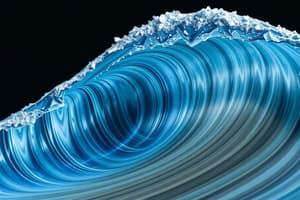Podcast
Questions and Answers
The term 'temblor' is used to describe a type of earthquake that is usually brief but may repeat over a long period of time.
The term 'temblor' is used to describe a type of earthquake that is usually brief but may repeat over a long period of time.
False (B)
Small earthquakes are known to take down buildings and cause death and injury.
Small earthquakes are known to take down buildings and cause death and injury.
False (B)
Earthquakes are classified as violent shocks and slight tremors.
Earthquakes are classified as violent shocks and slight tremors.
False (B)
The vibration from a large earthquake lasts for a few hours known as aftershocks.
The vibration from a large earthquake lasts for a few hours known as aftershocks.
There may be an average of 100,000 earthquakes every year that can cause damage.
There may be an average of 100,000 earthquakes every year that can cause damage.
Earthquakes are usually classified as either small or violent.
Earthquakes are usually classified as either small or violent.
The vibration from a small earthquake can last for a few days.
The vibration from a small earthquake can last for a few days.
Aftershocks are a type of earthquake that occurs over a long period of time.
Aftershocks are a type of earthquake that occurs over a long period of time.
The term 'quake' is used to describe a type of seismic wave.
The term 'quake' is used to describe a type of seismic wave.
Richter is credited with the discovery of aftershocks.
Richter is credited with the discovery of aftershocks.
Seismic waves travel through the earth's atmosphere.
Seismic waves travel through the earth's atmosphere.
Only about 100 earthquakes can cause damage each year.
Only about 100 earthquakes can cause damage each year.
Flashcards are hidden until you start studying
Study Notes
Earthquakes
- Earthquakes are one of the most deadly natural hazards, causing catastrophic loss of human lives and economic damage.
- An earthquake is a vibration through the earth's crust, resulting from powerful movement of rocks in the earth's crust.
Causes of Earthquakes
- The powerful movement of rocks in the earth's crust triggers a rapid release of energy, creating seismic waves that travel through the earth.
Characteristics of Earthquakes
- Earthquakes are usually brief, but may repeat over a long period of time.
- Large earthquakes begin with slight tremors, rapidly developing into violent shocks.
- The vibrations from a large earthquake last for a few days, known as aftershocks.
- Small earthquakes are usually slight tremors, causing little to no damage.
Effects of Earthquakes
- Large earthquakes can cause buildings to collapse, resulting in death and injury.
Statistics
- There are approximately 500,000 earthquakes every year.
- Only about 100,000 of these earthquakes can be felt.
- Around 100 earthquakes can cause damage each year.
Earthquakes
- Earthquakes are one of the most deadly natural hazards, causing catastrophic loss of human lives and economic damage.
- An earthquake is a vibration through the earth's crust, resulting from powerful movement of rocks in the earth's crust.
Causes of Earthquakes
- The powerful movement of rocks in the earth's crust triggers a rapid release of energy, creating seismic waves that travel through the earth.
Characteristics of Earthquakes
- Earthquakes are usually brief, but may repeat over a long period of time.
- Large earthquakes begin with slight tremors, rapidly developing into violent shocks.
- The vibrations from a large earthquake last for a few days, known as aftershocks.
- Small earthquakes are usually slight tremors, causing little to no damage.
Effects of Earthquakes
- Large earthquakes can cause buildings to collapse, resulting in death and injury.
Statistics
- There are approximately 500,000 earthquakes every year.
- Only about 100,000 of these earthquakes can be felt.
- Around 100 earthquakes can cause damage each year.
Studying That Suits You
Use AI to generate personalized quizzes and flashcards to suit your learning preferences.




